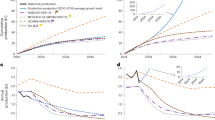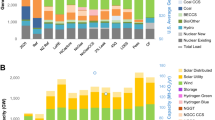Abstract
Great Britain’s overall carbon emissions fell by 6% in 2016, due to cleaner electricity production. This was not due to a surge in low-carbon nuclear or renewable sources; instead it was the much-overlooked impact of fuel switching from coal to natural gas generation. This Perspective considers the enabling conditions in Great Britain and the potential for rapid fuel switching in other coal-reliant countries. We find that spare generation and fuel supply-chain capacity must already exist for fuel switching to deliver rapid carbon savings, and to avoid further high-carbon infrastructure lock-in. More important is the political will to alter the marketplace and incentivize this switch, for example, through a stable and strong carbon price. With the right incentives, fuel switching in the power sector could rapidly achieve on the order of 1 GtCO2 saving per year worldwide (3% of global emissions), buying precious time to slow the growth in cumulative carbon emissions.
This is a preview of subscription content, access via your institution
Access options
Access Nature and 54 other Nature Portfolio journals
Get Nature+, our best-value online-access subscription
$29.99 / 30 days
cancel any time
Subscribe to this journal
Receive 12 digital issues and online access to articles
$119.00 per year
only $9.92 per issue
Buy this article
- Purchase on Springer Link
- Instant access to full article PDF
Prices may be subject to local taxes which are calculated during checkout






Similar content being viewed by others
References
Le Quéré, C. et al. Global carbon budget 2017. Earth Syst. Sci. Data Discuss. http://doi.org/chkq (2017).
Peters, G. P. et al. Towards real-time verification of CO2 emissions. Nat. Clim. Change 7, 848–850 (2017).
IPCC Climate Change 2014: Mitigation of Climate Change 31–108 (eds Edenhofer, O. et al.) (Cambridge Univ. Press, 2014) (IPCC, 2014).
Energy Roadmap 2050: Impact Assessment and Scenario Analysis (European Commission, 2012).
Energy Technology Perspectives 2015 (IEA, 2015).
BP Statistical Review of World Energy 2017 (BP, 2017).
IPCC Climate Change 2014: Mitigation of Climate Change 1–30 (eds Edenhofer, O. et al.) (Cambridge Univ. Press, 2014) (IPCC, 2014).
20 Years of Carbon Capture and Storage — Accelerating Future Deployment 115 (IEA, 2016).
Energy Technology Perspectives 2016 (IEA, ETP, 2014).
World Energy Issue Monitor 2017 156 (World Energy Council, 2017).
Reiner, D. M. Learning through a portfolio of carbon capture and storage demonstration projects. Nat. Energy 1, 15011 (2016).
Allen, M. R. et al. Warming caused by cumulative carbon emissions towards the trillionth tonne. Nature 458, 1163–1166 (2009).
Staffell, I. Measuring the progress and impacts of decarbonizing British electricity. Energy Policy 102, 463–475 (2017).
Balcombe, P., Anderson, K., Speirs, J., Brandon, N. & Hawkes, A. Methane and CO 2 Emissions from the Natural Gas Supply Chain: an Evidence Assessment (Sustainable Gas Institute, 2015).
Provisional UK Greenhouse Gas Emissions National Statistics 2016 (Department for Business, Energy & Industrial Strategy, accessed 24 January 2018); http://go.nature.com/2ESXWX8
CO 2 Emissions from Fuel Combustion (IEA, 2017); http://go.nature.com/2Gw9xbU
World Energy Balances 2017 Preliminary Edition (IEA, 2017).
Winskel, M. When systems are overthrown. Soc. Stud. Sci. 32, 563–598 (2002).
Historical Electricity Data: 1920 to 2016 (DECC, accessed 14 October 2017); http://go.nature.com/2FlO6Ks
Monthly Energy Review January 2018 Table 7.2a (Energy Information Administration, accessed 14 October); http://go.nature.com/2CBrYJB
Provisional UK Greenhouse Gas Emissions National Statistics 2016 (Department for Business, Energy and Industrial Strategy, accessed 14 October 2017); http://go.nature.com/2ESXWX8
Grams, C. M., Beerli, R., Pfenninger, S., Staffell, I. & Wernli, H. Balancing Europe’s wind-power output through spatial deployment informed by weather regimes. Nat. Clim. Change 7, 557–562 (2017).
The Energy Transition in the Power Sector in Europe 2016 (Sandbag, 2017).
Greenhouse Gas Emissions (Department of Energy and Climate Change, 2017).
Annual Statement of Emissions for 2015 (Department for Business, Energy and Industrial Strategy, 2017).
The Carbon Plan: Delivering our low carbon future137–207 (DECC, 2011).
Rudd, A. Amber Rudd’s Speech on a New Direction for UK Energy Policy (UK Government, 2015); http://go.nature.com/2CczbEt
Coal Generation in Great Britain 16 (Department for Business, Energy and Industrial Strategy, 2016).
Littlecott, C. UK Coal Phase Out: the International Context (E3G, 2016).
Gross, R., Speirs, J., Hawkes, A., Skillings, S. & Heptonstall, P. Could Retaining Old Coal Lead to a Policy Own Goal? (Imperial College London, 2014).
Rallo, M., Lopez-Anton, M. A., Contreras, M. L. & Maroto-Valer, M. M. Mercury policy and regulations for coal-fired power plants. Environ. Sci. Pollut. Res. 19, 1084–1096 (2012).
Burger, B. Net Installed Electricity Generation Capacity in Germany (Fraunhofer, 2017); http://go.nature.com/2BFBOgU
Coal Consumption and Stocks (ET2.6) (Department for Business, Energy and Industrial Strategy, 2017); http://go.nature.com/2tjMAXu
Historical Coal Data: Coal Production, Availability and Consumption 1853 to 2016 (Department for Business, Energy and Industrial Strategy, 2017); http://go.nature.com/2GwX6g3
McGlade, C. & Ekins, P. The geographical distribution of fossil fuels unused when limiting global warming to 2 °C. Nature 517, 187–190 (2015).
Climate Change Minister Claire Perry Launches Powering Past Coal Alliance at COP23 (Department for Business, Energy and Industrial Strategy, 2017).
The Large Combustion Plants Directive 100 (Department of Environment Food and Rural Affairs, 2010).
Climate Change Act 2008: Elizabeth II Ch. 27 (UK Government. 2008); http://www.legislation.gov.uk/ukpga/2008/27/pdfs/ukpga_20080027_en.pdf
2010 to 2015 Government Policy: UK Energy Security Appendix 5 (Department of Energy and Climate Change, 2015).
The Three Billion Tonne Problem (Sandbag, 2017).
Venmans, F. M. J. The effect of allocation above emissions and price uncertainty on abatement investments under the EU ETS. J. Clean. Prod. 126, 595–606 (2016).
Hintermann, B., Peterson, S. & Rickels, W. Price and market behavior in phase II of the EU ETS: A review of the literature. Rev. Environ. Econ. Policy 10, 108–128 (2016).
Borghesi, S. & Montini, M. The best (and worst) of GHG emission trading systems: comparing the EU ETS with its followers. Front. Energy Res 4, 83 (2016).
Hirst, D. Carbon Price Floor (CPF) and the Price Support Mechanism Briefing Paper No. 05927 (2018).
The Carbon Price Thaw Post-Freeze Future of the GB Carbon Price Report for Non-Subscribers (Aurora Energy Research, 2017).
Howard, R. Next steps for the carbon price floor. Policy Exchange (18 November 2016).
EEF Full Budget Response (EEF, accessed 16 November 2017).
Estimated Impacts of Energy and Climate Change Policies on Energy Prices and Bills 98 (Department of Energy and Climate Change, 2014).
Grover, D., Shreedhar, G. & Zenghelis, D. The Competitiveness Impact of a UK Carbon Price: What do the Data Say? (ESRC Centre for Climate Change Economics and Policy, Grantham Research Institute on Climate Change and the Environment, 2016).
Making sense of capacity cuts in China. The Economist (9 September 2017).
Delarue, E. & D’haeseleer, W. Greenhouse gas emission reduction by means of fuel switching in electricity generation: Addressing the potentials. Energy Convers. Manag. 49, 843–853 (2008).
Lafrancois, B. A. A lot left over: Reducing CO2 emissions in the United States’ electric power sector through the use of natural gas. Energy Policy 50, 428–435 (2012).
Cullen, J. A. & Mansur, E. T. Inferring carbon abatement costs in electricity markets: A revealed preference approach using the shale revolution. Am. Econ. J. Econ. Policy 9, 106–133 (2017).
Monthly Energy Review January 2018 187 (US Energy Information Administration, 2018).
Energy Study 2016: Reserves, Resources and Availability of Energy Resources — Summary 16 (BGR, 2016).
Evaluation Tables on the Energy Balance for Germany — 1990 to 2015 24 (Arbeitsgemeinschaft Energiebilanzen, 2016).
Villa, M. Higher than you think: myths and reality of Nord Stream’s utilization rates. ISPI (17 April 2016).
Green, R. & Staffell, I. Electricity in Europe: Exiting fossil fuels? Oxford Rev. Econ. Policy 32, 282–303 (2016).
Power Statistics — Monthly Domestic Values (ENTSO-E, 2017); http://go.nature.com/2CB6a0N
Linkenheil, C. P., Göss, S. & Huneke, F. A CO2 price floor for Germany. energypost (26 January 2017).
Martin, R., Muûls, M., de Preux, L. B. & Wagner, U. J. On the empirical content of carbon leakage criteria in the EU Emissions Trading Scheme. Ecol. Econ. 105, 78–88 (2014).
Zhang, X., Myhrvold, N. P., Hausfather, Z. & Caldeira, K. Climate benefits of natural gas as a bridge fuel and potential delay of near-zero energy systems. Appl. Energy 167, 317–322 (2016).
Lenox, C. & Kaplan, P. O. Role of natural gas in meeting an electric sector emissions reduction strategy and effects on greenhouse gas emissions. Energy Econ. 60, 460–468 (2016).
Pfeiffer, A., Millar, R., Hepburn, C. & Beinhocker, E. The ‘2 °C capital stock’ for electricity generation: Committed cumulative carbon emissions from the electricity generation sector and the transition to a green economy. Applied Energy 179, 1395–1408 (2016).
Busch, C. & Gimon, E. Natural gas versus coal: Is natural gas better for the climate? Electr. J. 27, 97–111 (2014).
Hausfather, Z. Bounding the climate viability of natural gas as a bridge fuel to displace coal. Energy Policy 86, 286–294 (2015).
Pye, S., Sabio, N. & Strachan, N. An integrated systematic analysis of uncertainties in UK energy transition pathways. Energy Policy 87, 673–684 (2015).
Pye, S., Li, F. G. N., Price, J. & Fais, B. Achieving net-zero emissions through the reframing of UK national targets in the post-Paris Agreement era. Nat. Energy 2, 17024 (2017).
Helping the UK Achieve its Carbon Reduction Targets (EDF Energy, 2015).
Wilson, I. A. G., McGregor, P. G. & Hall, P. J. Energy storage in the UK electrical network: Estimation of the scale and review of technology options. Energy Policy 38, 4099–4106 (2010).
Wilson, I. A. G., Rennie, A. J. R. & Hall, P. J. Great Britain’s energy vectors and transmission level energy storage. Energy Proc. 62, 619–628 (2014).
Anderson, K. & Peters, G. The trouble with negative emissions. Science 354, 182–183 (2016).
World Electric Power Plants Database: Global Market Data and Price Assessments (Platts, 2017); http://go.nature.com/2GwfcOX
Global Energy and CO 2 Data (Enerdata, accessed 24 January 2018); http://go.nature.com/2FigCx5
Pfenninger, S., DeCarolis, J., Hirth, L., Quoilin, S. & Staffell, I. The importance of open data and software: Is energy research lagging behind? Energy Policy 101, 211–215 (2017).
Projected Costs of Generating Electricity (OECD Publishing, 2015).
Levelized Cost and Levelized Avoided Cost of New Generation Resources in the Annual Energy Outlook 2017 (Energy Information Administration, 2017).
Electricity Generation Costs (Department for Business, Energy and Industrial Strategy, 2016).
Bloomberg New Energy Finance, US Power Stack (Bloomberg, 2017); http://go.nature.com/2HxMy1v
CO 2 Emissions From Fuel Combustion: Allocation of Emissions from Electrical Heat (IEA, 2017).
CO 2 Emissions from Fuel Combustion 2016 (IEA, 2016).
Technology Roadmap — High Efficiency, Low-Emissions Coal-Fired Power Generation 8–20 (IEA, 2012).
Bobmann, T., Staffell, I., Boβmann, T. & Staffell, I. The shape of future electricity demand: Exploring load curves in 2050s Germany and Great Britain. Energy 90, 1317–1333 (2015).
Wilson, I. A. G. & Staffell, I. Databook for Nature Energy perspective on coal to gas generation. Figureshare (2018); http://doi.org/ckp9
World Energy Statistics and Balances (IEA, 2017); http://go.nature.com/2EUxYCx
EUA Futures — Emissions Index — Data (ICE, 2017); http://go.nature.com/2EGU4sW
Quaterly Energy Prices (Department for Business, Energy and Industrial Strategy, 2013).
Acknowledgements
This research was undertaken as part of the UKERC research programme EP/L024756/1, and I.S. was funded by the Engineering and Physical Sciences Research Council through project EP/M001369/1.
Author information
Authors and Affiliations
Corresponding author
Ethics declarations
Competing interests
The authors declare no competing interests.
Additional information
Publisher’s note: Springer Nature remains neutral with regard to jurisdictional claims in published maps and institutional affiliations.
Supplementary information
Supplementary Tables
Supplementary Tables 1–4
Rights and permissions
About this article
Cite this article
Wilson, I.A.G., Staffell, I. Rapid fuel switching from coal to natural gas through effective carbon pricing. Nat Energy 3, 365–372 (2018). https://doi.org/10.1038/s41560-018-0109-0
Received:
Accepted:
Published:
Issue Date:
DOI: https://doi.org/10.1038/s41560-018-0109-0
This article is cited by
-
Optimal reduction and equilibrium carbon allowance price for the thermal power industry under China’s peak carbon emissions target
Financial Innovation (2023)
-
Torrefied plastic-fiber fuel pellets as a replacement for fossil fuels — a case study life cycle assessment for Green Bay, Wisconsin, USA
The International Journal of Life Cycle Assessment (2023)
-
The expansion of natural gas infrastructure puts energy transitions at risk
Nature Energy (2022)
-
Identifying chemically similar multiphase nanoprecipitates in compositionally complex non-equilibrium oxides via machine learning
Communications Materials (2022)
-
Catalytic production of low-carbon footprint sustainable natural gas
Nature Communications (2022)



